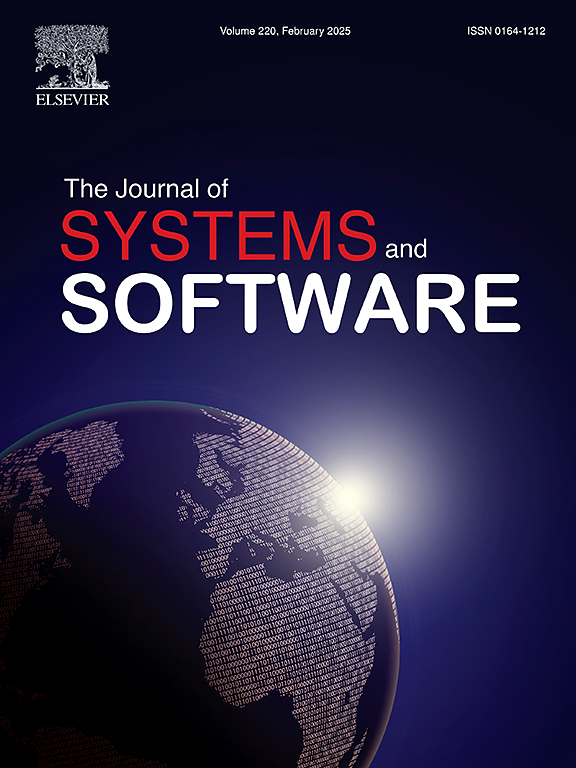MAS4DT: A novel proposal for developing Digital Twins following a Multi-Agent system approach
IF 3.7
2区 计算机科学
Q1 COMPUTER SCIENCE, SOFTWARE ENGINEERING
引用次数: 0
Abstract
The Digital Twin (DT) concept has evolved into its current definition since its creation in 2003. It now comprises a physical entity and its virtual counterpart, plus their interrelated data connections and uses the virtual counterpart to monitor, simulate, control, and predict the physical entity's behaviour. Most of the proposals in this field have focused on specific use cases rather than on describing the proper guidelines for designing DTs. This paper addresses a significant research challenge by means of a domain-agnostic proposal for DT design. Our new proposal, MAS4DT, is a method for guiding stakeholders in their DT designs following the Multi-Agent Systems (MAS) paradigm, so that the MAS provides the support for the development of the virtual counterpart of the DT. In this work, the application of MAS4DT is illustrated by a DT wind turbine design. We also describe MAS4DT's evaluation in a controlled experiment of its understandability with regard to the 5 dimensions model, another well-known proposal for this type of design. The evaluation was designed considering the properties that a DT should support. The results show that MAS4DT outperforms the 5 dimensions model and indicates its potential use for DT design. Finally, this controlled experiment represents the first empirical validation of proposals for developing DT. The design of this controlled experiment can be used in subsequent similar evaluations.
MAS4DT:基于多代理系统方法开发数字孪生的新建议
自2003年创建以来,数字孪生(DT)概念已经发展到目前的定义。它现在包括一个物理实体和它的虚拟对手,加上它们相互关联的数据连接,并使用虚拟对手来监视、模拟、控制和预测物理实体的行为。该领域的大多数建议都集中在特定的用例上,而不是描述设计dtd的适当指导方针。本文通过一种与领域无关的DT设计方案解决了一个重大的研究挑战。我们的新提案MAS4DT是一种指导利益相关者遵循多代理系统(MAS)范式进行DT设计的方法,以便MAS为DT的虚拟对应物的开发提供支持。在这项工作中,MAS4DT的应用是通过DT风力发电机的设计说明。我们还描述了MAS4DT在5维模型的可理解性的对照实验中的评估,5维模型是这类设计的另一个众所周知的建议。评估的设计考虑了DT应该支持的属性。结果表明,MAS4DT优于5维模型,并表明其在DT设计中的潜在用途。最后,这个对照实验代表了发展DT的建议的第一个实证验证。本对照实验的设计可用于后续的类似评价。
本文章由计算机程序翻译,如有差异,请以英文原文为准。
求助全文
约1分钟内获得全文
求助全文
来源期刊

Journal of Systems and Software
工程技术-计算机:理论方法
CiteScore
8.60
自引率
5.70%
发文量
193
审稿时长
16 weeks
期刊介绍:
The Journal of Systems and Software publishes papers covering all aspects of software engineering and related hardware-software-systems issues. All articles should include a validation of the idea presented, e.g. through case studies, experiments, or systematic comparisons with other approaches already in practice. Topics of interest include, but are not limited to:
•Methods and tools for, and empirical studies on, software requirements, design, architecture, verification and validation, maintenance and evolution
•Agile, model-driven, service-oriented, open source and global software development
•Approaches for mobile, multiprocessing, real-time, distributed, cloud-based, dependable and virtualized systems
•Human factors and management concerns of software development
•Data management and big data issues of software systems
•Metrics and evaluation, data mining of software development resources
•Business and economic aspects of software development processes
The journal welcomes state-of-the-art surveys and reports of practical experience for all of these topics.
 求助内容:
求助内容: 应助结果提醒方式:
应助结果提醒方式:


